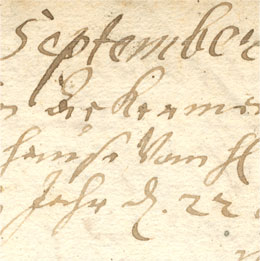On what basis is the crucifix in the Koeru church attributed to Ackermann?
The Koeru church crucifix has been attributed to Christian Ackermann on the basis of style analysis. The figure of Christ is very masterfully carved in its overall form, as well as in its level of detail.
What can the Koeru crucifix be compared to?
The Koeru crucifix can be compared to two figures of the crucified Christ: 1) the statue of the Crucified One in the Calvary Group on the original central panel of the Hageri Church retable, which Ackermann probably made in the first half of the 1680s, and 2) the crucifix at the Art Museum of Estonia that has so far been attributed to Ackermann with a question mark. The original location of this crucifix is unknown. Judging by the sharpness of its carved contours, the crucifix dates back to the master’s later creative period, in other words the beginning of the 18th century.
Of the nearly life-size statues of the crucified Christ, the Koeru crucifix should be compared first and foremost to the figure belonging to the Kullamaa church Calvary group, which according to ecclesiastical sources is Ackermann’s work from 1682. It should also be compared to the Christ in the chancel arch group from 1697 in Tallinn’s Cathedral, which had hitherto been attributed to Ackermann’s assistant Hinrich Martens.
What is the most surprising aspect of the Koeru crucifix?
The most surprising aspect is the naturalism of the Koeru church crucifix: the appearance of Christ as he died on the cross. Modelling polychromy has been discovered underneath the present paint layerin the course of the conducted analyses: Christ’s face is painted like a portrait on canvas. There is a greenish base tone that gleams through beneath the flesh tone to achieve an effect that approximates the natural colour of a dead body.
In the conviction that its original colours are in good condition, it was decided in 2020 to remove the secondary finishing coats and to exhibit the sculpture in its original colours. A monochromatic white opaque paint concealed its pale flesh, which was painted in a modelling manner, its silver loincloth, its brown hair, and its green crown of thorns adorned using lustre technique. Figurative paintings of high quality depicting the four evangelists surprisingly emerged from the tondos at the ends of the cross, which had originally been painted black. Such paintings are very rare in Lutheran church art in terms of both the quality of their execution and their iconography.
Additionally, comparison of the artist’s style affirmed that the painting The Last Supper on canvas, which belongs to the collection of Tallinn’s City Museum, and the paintings at the ends of the cross of the Koeru crucifix are the work of the same artist. It has not been possible to connect practically any single baroque painting in Estonia to the name of a specific master. Finding two works by one (anonymous) artist and associating them with one another is even less likely. Connecting two works by a single author is already an important find that expands our vision of baroque art.
